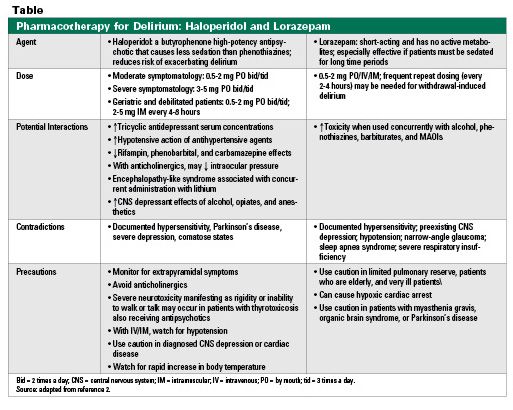Publication
Article
Pharmacy Times
Delirium: A Medical Emergency
Caregivers may be alarmed by delirium's sudden onset and the drastic behavior changes it brings. Pharmacists should be prepared to advise that delirium is a medical emergency that requires immediate treatment.
Ms. Wick is a senior research pharmacist at the National Cancer Institute, National Institutes of Health, Bethesda, Maryland. Dr. Zanni is a psychologist and health-systems consultant based in Alexandria, Virginia. Views expressed in this article are those of the authors and not those of any government agency.
Delirium is an acute syndrome characterized by 4 core features:
• Disturbance of consciousness (inability to maintain focus, attention, and awareness of the environment)
• Cognitive and perceptual disturbances (memory and language deficits, disorganized speech, disorganized thought processes)
• Sudden onset, usually over hours or days, with symptom fluctuations over the course of a day. Sudden onset distinguishes delirium from dementia, which is characterized by a slow and insidious course.
• Symptoms stemming from direct physiological causes (substance abuse or substance withdrawal, adverse medication reactions, dehydration, malnutrition, infections, head trauma, cerebral hemorrhage, electrolyte abnormalities, hepatic or renal failure, hypoperfusion states, and postoperative states)1,2
Delirium, a medical emergency, requires immediate interventions. Because it represents a drastic change in personality, loved ones often bring these patients to the emergency department. Hospital admission is a common necessity. Sadly, from 10% to 26% of these patients die,3 and for those developing delirium during hospital stay, mortality ranges from 22% to 76%.4 Up to 80% of patients develop delirium near death (labeled terminal delirium).1,5
Assessment
Research implicates cholinergic failure in delirium’s pathogenesis. Drugs, including OTCs, are delirium’s most common cause, even when prescribed at therapeutic levels. Elders are particularly at risk for drug-induced delirium. Drugs posing the highest delirium risk are antidepressants, antiparkinsonian agents, benzodiazepines, centrally acting agents, corticosteroids, lithium, and opioid analgesics. Agents presenting moderate delirium risk include alphablockers, antiarrhythmics, antipsychotics, beta-blockers, digoxin, nonsteroidal anti-inflammatory drugs, and postganglionic sympathetic blockers.6
Assessment focuses on identifying delirium’s cause. Practitioners often turn attention first to current medications taken, substance abuse or withdrawal, existing comorbid illnesses, and symptoms of infection. Laboratory work-up—including electrolytes, glucose, renal and liver function tests, and toxicology—are used, frequently augmented by imaging studies to detect stroke, hemorrhage, and structural lesions. Despite comprehensive tests, delirium’s cause is unidentified in approximately 16% of patients.2
Treatment
Treatment is 2-fold: treating delirium’s underlying cause, if known, and pharmacotherapy for symptom management. Neuroleptics and benzodiazepines are commonly used, alone or in combination.
Neuroleptics are first-line agents that target delirium’s hyperactive arousal and its psychotic-like cognitive and perceptual impairments; haloperidol is considered the most effective agent, but some practitioners prefer risperidone because it is associated with fewer extrapyramidal adverse effects.1,2 Clinicians use benzodiazepines for their sedative effect and for substance withdrawal— induced delirium. All agents should be discontinued once symptoms subside.
Patients with alcoholism and those suffering from malnutrition are prone to thiamine and vitamin B12 deficiency, which also increases delirium’s risk. Thiamine hydrochloride or cyanocobalamin can improve their clinical condition. 2
Up to 80% of patients with mild delirium may remain undiagnosed,7 especially those in the elder population whose symptoms might be confused with other conditions. Consequently, pharmacists should develop a healthy suspicion for delirium, especially drug-induced delirium. â–

References
1. American Psychiatric Association. Diagnostic and statistical manual of metal disorders. 4th ed. Washington, DC: American Psychiatric Association, 1994.
2. Kannayiram A. Delirium. Available http://www.emedicine.com/med/TOPIC3006.HTM. Accessed October 26, 2008.
3. McCusker J, Cole M, Abrahamowicz M, Primeau F, Belzile E.
Delirium predicts 12-month mortality. Arch Intern Med. 2002 ;162:457-63.
4. No authors listed. Practice guideline for the treatment of patients with delirium. American Psychiatric Association. Am J Psychiatry. 1999;156(5 Suppl):1-20.
5. Emanuel L, Ferris F, MD; Charles F, von Gunten C, et al. The last hours of living: practical advice for clinicians. Available at http://www.medscape.com/viewprogram/5808. Accessed October 24, 2008.
6. No authors listed. Drug-induced delirium: diagnosis, management, and prevention. Drug Ther Perspect. 1997;10:5-9. Available at http://www.medscape.com/viewarticle/406246. Accessed October 26, 2008.
7. Marcantonio E. Delirium and dementia. In Beers MH (ed) The Merck Manual of Medical Information. Whitehous Station, NJ: Merck Research Laboratories, 2003.







